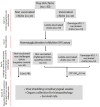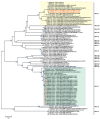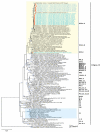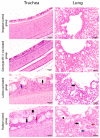Evolutionary Trajectories of Avian Avulaviruses and Vaccines Compatibilities in Poultry
- PMID: 36366369
- PMCID: PMC9698863
- DOI: 10.3390/vaccines10111862
Evolutionary Trajectories of Avian Avulaviruses and Vaccines Compatibilities in Poultry
Abstract
Newcastle disease virus (NDV) causes one of the highly infectious avian diseases in poultry leading to genuine financial misfortunes around the world. Recently, there has been an increasing trend in the number of ND-associated outbreaks in commercial Jordanian poultry flocks indicating a possible complex evolutionary dynamic of NDV infections in the country. To underpin the dynamics of circulating NDV strains and to assess the vaccine-escape potential, a total of 130 samples were collected from different poultry flocks in six Jordanian Governorates during 2019-2021. Twenty positive isolates, based on real-time reverse transcriptase PCR, were used for further genetic characterization and evolutionary analysis. Our results showed that there is a high evolutionary distance between the newly identified NDV strains (genotype VII.1.1) in this study and the commercially used vaccines (genotypes I and II), suggesting that circulating NDV field strains are under constant evolutionary pressure. These mutations may significantly affect flocks that have received vaccinations as well as flocks with insufficient immunity in terms of viral immunity and disease dynamics. To assess this further, we investigated the efficacy of the heterologous inactivated LaSota or homologous genotype VII.1.1 vaccine for their protection against virulent NDV in chicken. Vaccine-induced immunity was evaluated based on the serology, and protection efficacy was assessed based on clinical signs, survival rates, histopathology, and viral shedding. Chickens vaccinated with the inactivated genotype VII.1.1 based vaccine showed 100% protection with a significant reduction in virus shedding, and ameliorated histopathology lesions compared to LaSota vaccinated chicks that showed 60% protection. These results revealed that the usage of NDV inactivated vaccine from the circulating field strains can successfully ameliorate the clinical outcome and virus pathobiology in vaccinated chicks and will serve as an effective vaccine against the threat posed by commonly circulating NDV strains in the poultry industry.
Keywords: Jordan; avian orthoavulaviruses 1; efficacy; evolutionary pressure; vaccine.
Conflict of interest statement
The authors declare no conflict of interest. The funders had no role in the design of the study; in the collection, analyses, or interpretation of data; in the writing of the manuscript; or in the decision to publish the results.
Figures









Similar articles
-
Efficacy of Newcastle disease LaSota vaccine-induced hemagglutination inhibition antibodies against challenges with heterologous virulent strains of genotypes VII and IX.Vet Immunol Immunopathol. 2023 May;259:110591. doi: 10.1016/j.vetimm.2023.110591. Epub 2023 Apr 5. Vet Immunol Immunopathol. 2023. PMID: 37030151
-
Comparative efficacy of commercial inactivated Newcastle disease virus vaccines against Newcastle disease virus genotype VII in broiler chickens.Poult Sci. 2019 May 1;98(5):2000-2007. doi: 10.3382/ps/pey559. Poult Sci. 2019. PMID: 30561723
-
Protective efficacy of the Newcastle disease virus genotype VII-matched vaccine in commercial layers.Poult Sci. 2020 Mar;99(3):1275-1286. doi: 10.1016/j.psj.2019.10.063. Epub 2020 Feb 1. Poult Sci. 2020. PMID: 32111305 Free PMC article.
-
Newcastle disease vaccines-A solved problem or a continuous challenge?Vet Microbiol. 2017 Jul;206:126-136. doi: 10.1016/j.vetmic.2016.12.019. Epub 2016 Dec 16. Vet Microbiol. 2017. PMID: 28024856 Free PMC article. Review.
-
Immune responses of poultry to Newcastle disease virus.Dev Comp Immunol. 2013 Nov;41(3):447-53. doi: 10.1016/j.dci.2013.04.012. Epub 2013 Apr 25. Dev Comp Immunol. 2013. PMID: 23623955 Review.
Cited by
-
Detection of Avian Orthoavulavirus-1 genotypes VI.2.1 and VII.1.1 with neuro-viscerotropic tropism in some backyard pigeons (Columbidae) in Eastern Saudi Arabia.Front Vet Sci. 2024 Feb 27;11:1352636. doi: 10.3389/fvets.2024.1352636. eCollection 2024. Front Vet Sci. 2024. PMID: 38500603 Free PMC article.
-
The Development of Novel Reverse Transcription Loop-Mediated Isothermal Amplification Assays for the Detection and Differentiation of Virulent Newcastle Disease Virus.Int J Mol Sci. 2023 Sep 8;24(18):13847. doi: 10.3390/ijms241813847. Int J Mol Sci. 2023. PMID: 37762149 Free PMC article.
References
-
- Lamb R.A., Parks G.D. Paramyxoviridae: The viruses and their replication. In: Knipe D.M., Howley P.M., editors. Fields Virology. 5th ed. Lippincott Williams & Wilkins; Philadelphia, PA, USA: 2006. pp. 1449–1496.
LinkOut - more resources
Full Text Sources

